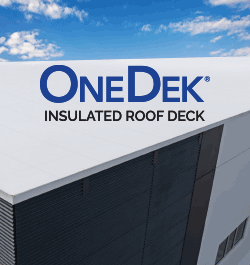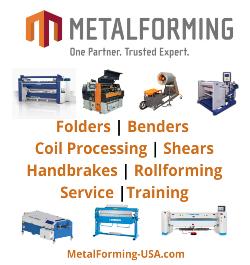UP TO THE MINUTE
Enhancing the environment with each roof edge

By Metal-Era®.
A well-designed roof edge system can significantly reduce a building’s carbon footprint and extend its lifecycle. Understand the function of this vital building component and let it inform your sustainable solutions.
A building’s roof edge system is a critical component of its design and can significantly impact its sustainability over the course of its lifecycle. Not only does perimeter edge metal prevent energy loss and water damage, but it can also improve the building’s durability, reducing its carbon footprint over time. Many roof edge products are prefabricated and utilize sustainable materials that can further protect the environment. This article identifies a number of sustainable benefits for roof edge systems and how their design and installation can promote greener solutions.
Energy efficiency
The roof edge plays a critical role in the energy efficiency of a building by helping to prevent energy loss along the perimeter. When a building's roof edge is improperly designed or installed, it can create gaps and cracks that allow air to flow freely in and out of the building. In the colder months, warm air from the interior can escape through the roof edge, causing the heating system to use more energy to regulate temperature; similarly, during warmer months, cool air from the interior can escape, requiring the cooling system to use more energy. Both cases cause an increase in the building’s energy bills and environmental impact.
Utilizing a properly designed and installed roof edge system will help to seal any gaps or cracks, providing a barrier against the elements, and can lead to significant energy savings and a lower carbon footprint. Roof edge can also enhance the overall energy efficiency of a building by allowing for the continuous installation of insulation materials, creating a seamless block against air leakage and energy loss. The use of insulation can help to regulate the temperature inside the building, which can further reduce energy consumption. Additionally, an energy-efficient roof edge can increase the building's value and appeal, as the market is increasingly seeking environmentally sustainable structures that save money in the long term. By utilizing a properly designed and installed roof edge system, buildings can enhance their overall energy efficiency, lower their energy bills and contribute towards sustainability.
Water management
The roof edge is also essential for managing water runoff, and it is vital to protecting the building's foundation from water damage to ensure its longevity. Roof edge systems are responsible for directing rainwater and snowmelt away from the roof and into the drainage system, preventing it from accumulating on the roof's surface. These systems can include typical roof edge pieces, like fascia, coping or drip edge, as well as gutters and other water management components. Without a properly installed roof edge system, water can seep into the building's walls and foundation, causing damage, mold and other issues, leading to a significant impact on the building’s lifespan.
One increasingly popular option is to channel water away from the building into an eco-friendly rainwater harvesting system where it can be collected and reused. This water management approach can conserve natural resources and mitigate the effects of heat islands by reducing the number of heat-absorbing surfaces and promoting vegetation growth. Collecting rainwater and snowmelt for irrigation or other non-potable uses reduces the strain on municipal water systems and supports sustainable landscaping practices. Whatever the approach, proper water management through a well-designed roof edge system can contribute to a more sustainable future for the building.
Sustainable, prefabricated materials
Sourcing sustainable, prefabricated materials for roof edge systems can make a significant difference in reducing the environmental impact of buildings and can lead to considerable cost savings over time. When selecting materials and sourcing the roof edge, it is important to consider factors such as durability, maintenance requirements and end-of-life disposal options. One sustainable option is using recycled materials, such as steel or aluminum, which have a high percentage of recycled content and can be recycled again at the end of their life cycle.
Choosing prefabricated roof edge metal can provide additional environmental benefits. Prefabricated roof edge metal made in controlled factory conditions can minimize resource waste from unnecessary production and optimize energy efficiencies, lowering the ecological impact of the manufacturing process. Also, selecting sustainable, prefabricated solutions for the roof edge can also provide significant cost savings over time. For example, prefabricated steel or aluminum – which we use for our products – can last longer, require less maintenance, and even be reused, reducing the need for replacement and repair, and decreasing building operational costs and environmental toll. All these benefits make using prefabricated, sustainable materials for the roof edge a wise choice, both for the building's environmental impact and the budget.
Tested, code compliant
Using tested, code compliant perimeter edge metal is a required aspect of sustainable roofing practices because it helps ensure protection from wind uplift, which can significantly affect the building’s lifespan. Wind uplift can substantially impair a building's roof system, leading to extensive property damage, potential safety hazards and even structural failure. To withstand high winds and prevent damage to the roof and building, it is essential to use roofing edge systems that are designed and tested to meet industry standards and building codes, like ANSI/SPRI/FM 4435/ES-1 and ANSI/SPRI GT-1. By reducing the risk of wind uplift, tested, code compliant roofing edge systems can help to extend the lifecycle of the roof and the building. This can lessen the environmental impact of roofing systems by minimizing the amount of waste generated and resources consumed in costly repair and replacement activities for roofing failures. Ultimately, using tested, code-compliant roofing edge systems helps to promote the safety and durability of buildings, which is essential for the long-term sustainability of any structure.
Conclusion
In conclusion, the roof edge system plays a crucial role in sustainable building practices, significantly impacting a building's energy efficiency, water management, and durability. Overlooking this important component can result in energy loss, water damage, and costly repairs or replacements. However, utilizing sustainable, prefabricated materials and tested, code-compliant roofing edge systems can offer significant environmental benefits and cost savings over time. Ultimately, paying attention to the design and installation of the roof edge can serve as a major step towards creating a greener future. Understanding the value of a properly designed and installed roof edge system can inform decisions that reduce a building's carbon footprint and promote long-term sustainability.
Original article source: Metal-Era
Learn more about Metal-Era in their Coffee Shop Directory or visit www.metalera.com.




















Comments
Leave a Reply
Have an account? Login to leave a comment!
Sign In